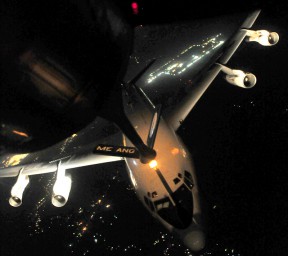
A KC-135 Stratotanker refuels a Joint Surveillance Terminal Attack Radar System (JSTARS) over Iraq, Dec. 18, 2011. The JSTARS mission was the last over Iraq during Operation New Dawn. The JSTARS provided airborne, stand-off range, surveillance and target acquisition radar, and command and control capabilities to ground personnel. (U.S. Air Force photo/Senior Airman Tyler Placie)
Curtiss-Wright Controls, Inc. announced Tuesday that it has been awarded an approximately $8 million follow-on production contract by Northrop Grumman Corp. to provide an upgraded Radar Signal Processing (RSP) solution for use in the U.S. Air Force Joint Surveillance and Target Attack Radar System (Joint STARS) program.
The estimated value of this follow-on order over the lifetime of the program is $22 million. Under the contract, the award began in November 2012. The program is expected to continue through 2015.
“We are very proud to have been selected by Northrop Grumman to supply our rugged embedded processing subsystem technology to support the Joint STARS aircraft’s advanced radar signal processing needs,” said Tom Quinly, President of Curtiss-Wright Controls. “This contract award reflects our success, including over three years of development and qualification testing, in significantly reducing the overall weight and size of the earlier RSP, while increasing system performance.”
About the RSP
The RSP is one of two subsystems that Curtiss-Wright supplies on the Joint STARS aircraft.
About Joint STARS
Joint STARS is the premier airborne command, control, intelligence, surveillance and reconnaissance (C2ISR) platform for the U.S. Air Force’s air-to-ground battle management and surveillance operations. The Air Force’s Radar Airborne Signal Processor (RASP) system performs the radar signal processing capabilities of the Joint STARS aircraft, enabling its ability to process data that results in the ability to locate targets. The contract is part of a larger upgrade to the RASP system used in Joint STARS.
The Curtiss-Wrights Controls Defense Solutions facility in Santa Clarita, California will design and manufacture the Radio Signal Processors. Upon completion, the RSPs will be shipped to Northrop Grumman in Melbourne, Florida.
About Curtiss-Wright Corporation
Curtiss-Wright Corp. is an innovative engineering company that provides highly engineered, critical function products, systems and services in the areas of flow control, motion control and surface treatment technologies to the defense, energy and commercial/industrial markets. The legacy company of Glenn Curtiss and the Wright brothers, Curtiss-Wright has a long tradition of design and manufacturing innovation and prides itself on long-standing customer relationships. The company employs approximately 10,000 people worldwide. For more information, visit www.curtisswright.com.
About Curtiss-Wright Controls, Inc.
Headquartered in Charlotte, NC, Curtiss-Wright Controls is the Controls segment of Curtiss-Wright Corporation and a leading designer and manufacturer of advanced technologies for niche actuation and drive applications, integrated sensors and controls, and electronic subsystems internationally for the aerospace, defense and industrial markets. For more information, visit www.cwcontrols.com.
Curtiss-Wright Valencia Plant to Design-Build More Airborne Radar Signal Processors